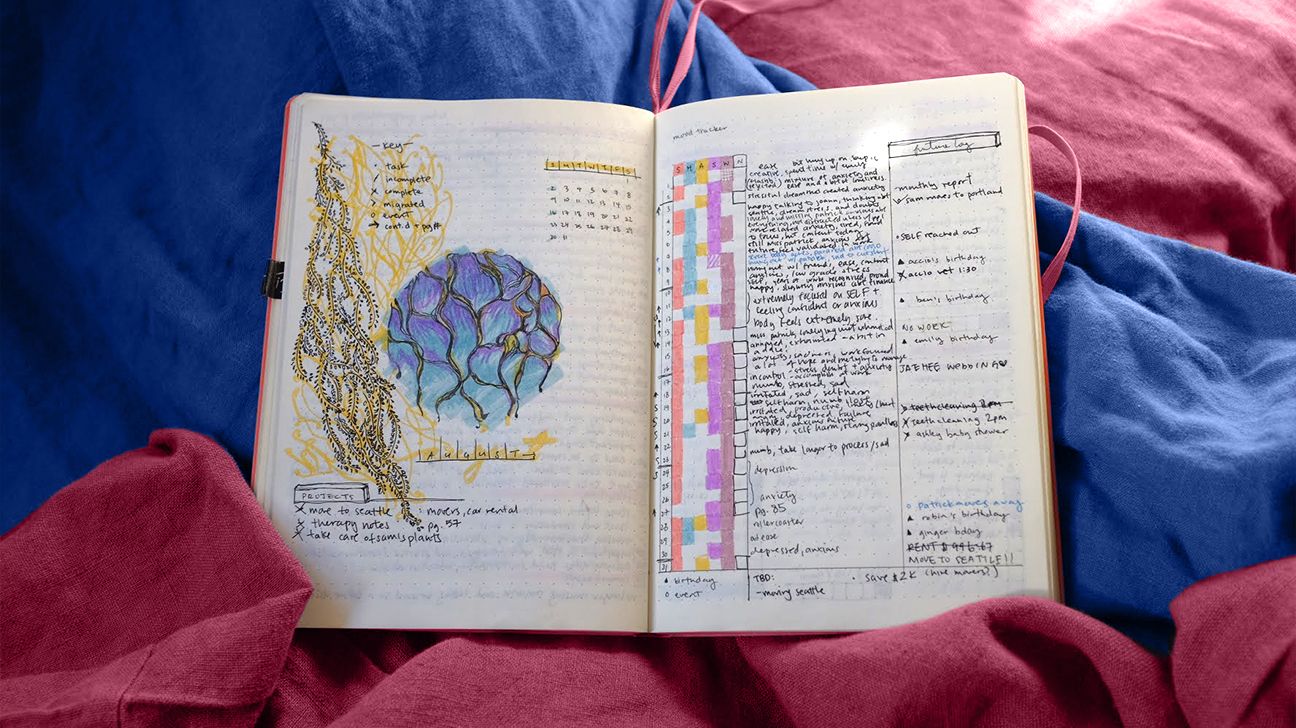By now, you’ve heard that journaling is good for your mental health. Positive affect journaling specifically has been shown to help manage mental distress, boost overall well-being, and improve our ability to do physical tasks. After all, what’s a better boost to working than the confidence to do it? Just me? OKAY.

Positive affect journaling (PAJ) — sometimes called gratitude journaling — is pretty much how it sounds. A simplified approach to expressive journaling, PAJ encourages you to write 15 to 20 minutes a day about the all the positives — the pluses, ups, and pros — of life and your experiences. It’s pretty much the daily practice of finding the silver lining.
Plot twist: I tried positive journaling in the fiery timeline of our Lord COVID-19 and found it incredibly invalidating to my own nonpositive emotions. If you’re like me, mood journaling might be the answer.
Mood journaling is the act of logging your mood so you can recognize trends, triggers, and use of your energy. You can mood journal just by logging how or what you felt. Or you can go more in-depth by naming your emotion and identifying what caused it, what resulted from it, and whether it was contextually appropriate.
Your goals for mood journaling are personal. Maybe you want to discover what causes your emotions or maybe you’re trying to understand your response to certain emotions.
For me, it was learning what my emotions were.
After many years of forcing positivity, 2020 was my final breaking point. In these trying times, employing toxic positivity was like looking for sunshine in a clogged toilet. The constant search pushed me toward emotional exhaustion, to a point where all I felt was bored… or so I thought.
When I told my therapist that I “knew” there were feelings I should have but just couldn’t feel them, she replied, “Honey, that’s depression.” And I realized I didn’t know my emotions at all.
A common misconception is that depression only (or always) causes sadness but what it actually does is numb your emotional and motivational capacity.
Specifically for me, depression showed up when there were feelings I didn’t want to feel. So, I would enter a state of emotional numbness until my brain decided the coast was clear. It turns out not feeling anything actually meant I was hiding a lot of damn feelings.
Beyond understanding my depression, the other benefits I gained after mood journaling for 6 months, included:
| Benefit | Why it works (for me) | Results |
| stronger emotional regulation | Helps me be less impulsive since I understand how or why an emotion is triggered. | Instead of rushing to react to an emotion (which can generate more guilt down the road), I slow down, take deep breaths, and assess the situation. |
| empowers me to advocate for my feelings | I’m able to clarify and be honest about how I feel rather than worry about how other’s think I may feel. | I can say, “I’m not mad, I’m sad and trying not to cry right now” to open up a conversation. |
| self-affirmation | How and why we feel emotions are unique to us, and the way we choose to acknowledge them requires self-affirmation. | When alone or unable to access care, I’m able to self-soothe and build a stronger, more confident relationship with myself. It also helps me trust my gut instincts. |
| aid for recognizing dissociation | It’s easy for me to feel helpless during episodes of dissociation, but tracking and reviewing the duration of past moments brings me hope. | Recognizing that an episode has stretched over a whole week helps “wake me up” and motivates me to break the cycle or get help. |
| better communication skills | The more I track, the faster I become at recognizing my moods, triggers, and why I feel a certain way. | Instead of ghosting people, for example, I’m able to articulate my bandwidth and show up as my best self. |
1. Identify your emotions
For those who’re like, “This is easy, I’ll just write down how I feel each day!” Good for you! Love your connection to your emotions, truly!
But if you’re more like me, you may want to start with an emotional wheel to help identify your feelings. For example, when I first started mood journaling, I referred to Geoffrey Roberts’ Feelings Wheel to help me label and articulate my emotions.
2. Choose a tracking method
You’ll want a tracking chart that fits on one page so you can look back at it at the end of each month. I personally use my bullet journal and make a three column table with 31 rows (or less, depending on the month) and just jot colors and notes down each day.
Google spreadsheet works well or, if you’re an app person, there are also plenty of mood tracker apps out there.
Note that while research shows apps are good for collection and reflection of emotions, they may not be as helpful with actual logging. Personally, apps didn’t work for me because the way they categorized emotions didn’t resonant with how I felt them.
3. Log it every day
Or at the very least, leave notes to yourself so that you can fill in the gaps at the end of the week. It doesn’t have to take more than a minute, especially if you have a key/legend on your past emotions. For me, not filling out a day eventually became a sign of onset depression.
4. Review it at the end of the month and make goals for the next month
For the first couple of months, it was pretty shocking to do the math. I discovered I was depressed 56 to 65 percent of the time, anxious 48 percent, and stressed more than 50 percent of the time! I felt positive only about 15 to 19 percent of the time.
Thanks to therapy though, I’ve learned not to get caught up in thinking that the nonpositive emotions are bad. Instead of making “be happier” my goal, I sought to decipher why I was depressed/stressed/anxious so often. I journaled to keep note of my triggers and if I started to notice columns and columns of depressed, I made more plans to practice self-care. Emotion regulation, baby.
It all depends on which ones you want to track! A few mistakes I notice people get caught up in are:
- the need to track everything
- to track what other people are tracking
- to bucket emotions the way other people feel them
Not everyone experiences emotions the same way. For me, I discovered that depression fits better under “bored” than it does under “sad.” Happiness also didn’t resonant for me so I tapped into calmer positive emotions, like relaxation, joy, and pride.
To help me better sort and understand my emotional processing, I also created my own emotion wheel. If you’ve gotten this far and feel psyched to decipher your personal emotional code, you might give this exercise a try! Here’s how to do it.
1. Identify your most frequent emotions in a negative/positive category
It may be easiest to start with emotions that feel polar opposites, although this isn’t always the case.
Here’s an example:
- Positive
- joyful
- hopeful
- proud
- Negative
- angry
- sad
- overwhelmed
2. Break down these 6 emotions into more granular categories
You don’t have to do this if you’re struggling to feel the exact words. I didn’t do this until 2 months in, when I realized that my anger had nuance, depending on the situation. For me, being able to name the nuance and get more specific was the key to letting my emotional flood gates go, and also in having supportive conversations with friends.
When I was ready, I looked at my core emotions and thought about past situations that brought up those feelings. I asked myself what made me feel that way.
It might be helpful to use the phrase “When [SITUATION] happened, I felt [EMOTION].” For example, “When they didn’t invite me over, I felt rejected.” This emotion goes in your second tier. Run this scenario several times for each core emotion until you feel like you’ve developed a language that can describe your day to day for a month.
Here’s an example of how my emotions became more nuanced:
| joyful | content, happy, playful |
| proud | respected, creative, accomplished |
| hopeful | safe, relaxed, rested |
| angry | irritated, violated, hostile |
| sad | lonely, depressed, rejected |
| overwhelmed | anxious, scared, insecure |
3. Fill it into a wheel like the one below (optional)
4. Don’t get locked into your emotions
After 6 months of logging, I’ve since made adjustments along the way. Whether it was new emotions I wanted to explore more or new emotions that arose because of the news cycle, I revisit my emotional wheel each month and decide how it may look or need to look for the next.
Mood journaling is one of those activities where you may have to try it before you understand how it works (for you). I made the mistake of going in with an intention to feel a certain way (aka to feel better), and it backfired by tripping up my ability to be authentic about the process.
I advise taking a more observational and curious approach. Simply seeing what your natural emotional states are may improve mental health and communication, especially with your care providers.
One of my favorite benefits of mood journaling is that I’ve gotten more creative over time. What was originally an ugly page of white-out marks and X’s has evolved into pages of color that even make bad days fun to look at (when I’m in the mood).
Christal Yuen is a senior editor at Greatist, covering all things beauty and wellness. Find her musing about therapy on Twitter.


